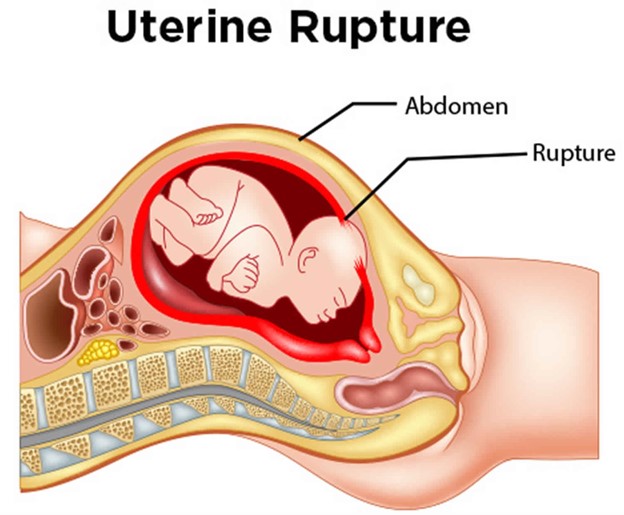A nurse is caring for a client who is in active labor and reports sudden, severe lower abdominal pain. The nurse observes a drop in the client's blood pressure and notes cool skin and pallor. The fetal heart rate tracing shows prolonged bradycardia. Which of the following complications should the nurse suspect?
Amniotic fluid embolism
Umbilical cord prolapse
Uterine rupture
Placenta previa
The Correct Answer is C
Uterine rupture. The sudden, severe lower abdominal pain, drop in blood pressure, and signs of shock such as cool skin and pallor all point to a potential intra-abdominal hemorrhage most likely due to Uterine rupture. Additionally, the prolonged bradycardia on the fetal heart rate tracing indicates that the baby may be experiencing fetal distress due to a compromised blood supply. Amniotic fluid embolism triggers an allergic reaction, causing a sudden onset of respiratory distress, hypotension, and cardiac arrest. Option D, placenta previa, occurs when the placenta implants in the lower uterine segment, partially or completely covering the cervical os. This can lead to painless vaginal bleeding but typically does not present with sudden, severe abdominal pain or signs of shock.

Nursing Test Bank
Naxlex Comprehensive Predictor Exams
Related Questions
Correct Answer is B,D,C,A
Explanation
The correct answer is choice B, D, C, A. B. Compress the bulb syringe: The nurse should first compress the bulb syringe to expel air from it. This ensures that when it is placed in the newborn’s mouth or nose, it can create suction to effectively remove mucus. D. Place the bulb syringe in the newborn's mouth: The nurse should then place the compressed bulb syringe into the newborn’s mouth first, as clearing the mouth is essential before the nose to prevent aspiration. C. Use the bulb syringe to suction the newborn's nose: After suctioning the mouth, the nurse should use the bulb syringe to suction the nose. Suctioning the nose after the mouth helps to clear the airway more effectively and reduce the risk of mucus being aspirated into the lungs. A. Assess the newborn for reflex bradycardia: After suctioning, the nurse should assess the newborn for any signs of reflex bradycardia, which can occur due to vagal stimulation during suctioning. This ensures the newborn's heart rate and overall well-being are monitored.
Correct Answer is C
Explanation
The correct answer is choice C, "Maintain scheduled mealtimes for yourself." The nurse should instruct the postpartum client with type 1 diabetes mellitus and who is breastfeeding her newborn to maintain scheduled mealtimes for herself to ensure stable blood glucose levels. The client should also monitor her blood glucose levels more frequently, aiming to maintain a level between 60 to 99 mg/dL before meals and less than 120 mg/dL one hour after meals. Breastfeeding can cause hypoglycemia, so the client should have a source of glucose nearby while nursing. The client should consume a balanced diet, including fruits, vegetables, whole grains, lean proteins, and low-fat dairy, and aim to consume at least 175 g of carbohydrates per day.
Whether you are a student looking to ace your exams or a practicing nurse seeking to enhance your expertise , our nursing education contents will empower you with the confidence and competence to make a difference in the lives of patients and become a respected leader in the healthcare field.
Visit Naxlex, invest in your future and unlock endless possibilities with our unparalleled nursing education contents today
Report Wrong Answer on the Current Question
Do you disagree with the answer? If yes, what is your expected answer? Explain.
Kindly be descriptive with the issue you are facing.
